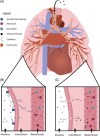McIntyre Powder and its potential contributions to cardiovascular disease risk: A literature review through the McIntyre Powder historical lens
- PMID: 35863903
- PMCID: PMC9541914
- DOI: 10.1002/ajim.23415
McIntyre Powder and its potential contributions to cardiovascular disease risk: A literature review through the McIntyre Powder historical lens
Abstract
McIntyre Powder (MP) is a fine aluminum powder that was developed to prevent silicosis in gold and uranium mine workers in Ontario, Canada, and was administered to miners there from 1943 to 1979. Mine workers were exposed to high concentrations (35.6 mg/m3 ) of MP for approximately 10 min before every work shift. Contemporary physical and chemical characterizations of this powder have revealed that 12% of the powder is in the ultrafine particle size-range (nanoparticles); and the remaining 88%, in the fine particulate size range (below 2.5 µm in diameter). The confluence of ultrafine particulate (UFP) composition and high airborne concentration of MP would be expected to overwhelm the defense mechanisms of the lung and increase the lung dust burden of the mine worker exposed to respirable dust in the mine. Published studies revealing associations between air pollution particulates and increased risk for cardiovascular disease (CVD) shown a dose-response relationship with ambient PM2.5 and UFP and suggest that miners exposed to MP may also be at increased risk of CVD. The historical perspective of the use of MP in northern Ontario hard-rock mines and its potential implications for CVD in exposed mine workers are discussed.
Keywords: PM2.5; atherosclerosis; nanoparticles; particle translocation; respiratory inflammation; ultrafine dust exposure.
© 2021 The Authors. American Journal of Industrial Medicine Published by Wiley Periodicals LLC.
Conflict of interest statement
The authors declare that there are no conflicts of interest.
Figures


Similar articles
-
Physical and chemical characterization of McIntyre Powder: An aluminum dust inhaled by miners to combat silicosis.J Occup Environ Hyg. 2019 Nov;16(11):745-756. doi: 10.1080/15459624.2019.1657581. Epub 2019 Sep 18. J Occup Environ Hyg. 2019. PMID: 31532354
-
Incidence of cardiovascular disease in a cohort of mine workers exposed to ultrafine aluminum powder in Ontario, Canada.Am J Ind Med. 2024 Oct;67(10):933-941. doi: 10.1002/ajim.23646. Epub 2024 Aug 23. Am J Ind Med. 2024. PMID: 39180259
-
Trading One Risk for Another: Consequences of the Unauthenticated Treatment and Prevention of Silicosis in Ontario Miners in the McIntyre Powder Aluminum Inhalation Program.New Solut. 2022 Feb;31(4):422-433. doi: 10.1177/10482911211037007. Epub 2021 Aug 8. New Solut. 2022. PMID: 34365861 Free PMC article.
-
Coal mine dust lung disease in miners killed in the Upper Big Branch disaster: a review of lung pathology and contemporary respirable dust levels in underground US coal mines.Occup Environ Med. 2022 May;79(5):319-325. doi: 10.1136/oemed-2021-107694. Epub 2021 Dec 8. Occup Environ Med. 2022. PMID: 34880046 Review.
-
Potential role of ultrafine particles in associations between airborne particle mass and cardiovascular health.Environ Health Perspect. 2005 Aug;113(8):934-46. doi: 10.1289/ehp.7938. Environ Health Perspect. 2005. PMID: 16079061 Free PMC article. Review.
References
-
- Institute for Health Metrics and Evaluation . Silicosis—Level 4 cause. Global Health Metrics Web site. Accessed September 7, 2021. http://www.healthdata.org/results/gbd_summaries/2019/silicosis-level-4-c...
-
- Newkirk TE, Hannon JWG, Campbell AD. The Physical and Chemical Characteristics and the Commercial Manufacture of a New Mcintyre Aluminium Powder. McIntyre Research Foundation; 1956.
-
- Hannon JWG. Inventor; McIntyre Research Foundation, assignee. Method of producing an atmosphere protective against silicosis. US patent 28240431958.
Publication types
MeSH terms
Substances
LinkOut - more resources
Full Text Sources

